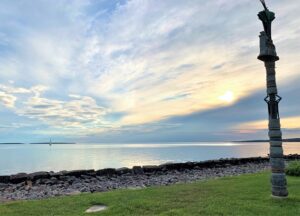An outside look

By Dr. David Shanahan
In 1615, Samuel de Champlain became the first European to travel through the lands between the Ottawa River and Lake Huron, and his journals provide the first account of the peoples who lived in that region. Led by guides, he arrived at Lake Nipissing and stayed for two days with the people he met there. He received “a very welcome reception.”
“During the time that I was with them, the Chief of this tribe and their most prominent men entertained us with many banquets according to their custom and took the trouble to go fishing and hunting with me, in order to treat me with the greatest courtesy possible. These people are very numerous, there being from seven to eight hundred souls, who live in general near the lake. This contains a large number of very pleasant islands, among others one more than six leagues long, with three or four fine ponds and a number of fine meadows; it is bordered by very fine woods, that contain an abundance of game, which frequent the little ponds.”
Fishing was an important part of the local economy, and Champlain wrote in his journal about the country around the Lake and the trade between the Nipissing and those living further inland:
“The northern side of the lake is very pleasant, with fine meadows for the grazing of cattle, and many little streams, discharging into the lake. They were fishing at that time in a lake very abundant in various kinds of fish, among others one a foot long that was very good. The lake is some eight leagues broad and twenty-five long, into which a river flows from the northwest (Sturgeon River), along which they go to barter the merchandise, which we give them in exchange for their peltry, with those who live on it, and who support themselves by hunting and fishing, their country containing great quantities of animals, birds, and fish.”
Champlain noted that the Nipissing caught many kinds of fish, which they dried and stored away for use during the winter months.
The next part of his journey took him down the French River to the shores of Lake Huron, which the people called Attigouautan.
“After resting two days with the Chief of the Nipissings, we re-embarked in our canoes and entered a river, by which this lake discharges itself. We proceeded down it some 35 leagues and descended several little falls by land and by water until we reached Lake Attigouautan. All this region is more unattractive than the preceding, for I saw along this river only ten acres of arable land, the rest being rocky and very hilly. It is true that near Lake Attigouautan we found some Indian corn, but only in small quantities.”
One of the biases of Europeans coming to North America was that they believed that only land that was cultivated was valuable. Land used for hunting, trapping, and fishing was considered “wasteland”, so Champlain was not impressed by the territory around the French River.
Food became an issue for Champlain and his men, although, near Lake Huron, his guides served up some squash, which Champlain found to be “acceptable to us, for our provisions began to give out”.
This he blamed on the local people, who “ate so heartily at the beginning that towards the end very little was left, although we had only one meal a day. But as I have mentioned before, we did not lack for blueberries and strawberries; otherwise, we should have been in danger of being reduced to straits.”
Blueberries and strawberries feature quite a lot in his descriptions of the indigenous diet, along with fish and game. At the mouth of the French River, the group came across a large gathering of Ottawa from Manitoulin Island, another group new to Champlain. He named them the Cheveux Relevés, or hair that was piled up on their heads. The Ottawa placed great importance on their appearance, and Champlain compared them favourably to the fashion-conscious French:
“We met 300 men of a tribe we named Cheveux Relevés, since their hair is very high and carefully arranged, and better dressed beyond all comparison than that of our courtiers, in spite of their irons and refinements. This gives them a handsome appearance. They have no breeches, and their bodies are very much pinked in divisions of various shapes. They paint their faces in various colours, have their nostrils pierced, and their ears adorned with beads. I visited them, became somewhat acquainted, and formed a friendship with them. I gave a hatchet to their chief, who was as much pleased and delighted with it as if I had given him some rich present.”
Although Champlain bypassed Manitoulin and headed south for an historic rendezvous with the Iroquois, he asked the Chief of the Ottawa about his territory, which the Chief “pictured to me with coal on the bark of a tree.”
The 300 Ottawa had travelled to the French River to dry blueberries for eating in winter “and when they can find nothing else. They have as arms only the bow and arrow, made in the manner you see depicted, and which they regularly carry; also a round shield of dressed leather made from an animal like the buffalo”.
This is the first record by Europeans of the lands and people between Lake Nipissing and Lake Huron.
Dr. David Shanahan has worked on First Nations treaty and land claim issues for the past 30 years.


